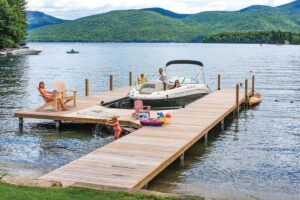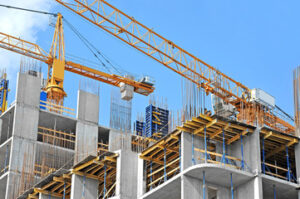Dock Lifts Charleston SC is a valuable asset for property owners on lakes, ponds, and rivers. However, the dock’s exposure to the elements can damage it over time.
Knowing when to repair a dock or replace it can save money or prevent serious injury. Here are some signs that a dock needs repairs or replacement:

Wood and water are not a natural mix, so it’s not uncommon for wooden boat docks to experience mild rot as time passes. If limited to small dock sections, the rot can be sanded down and repaired. However, if the rot is widespread, it’s most likely a sign that the dock is nearing the end of its life and should be replaced.
Docks from pressure-treated wood are generally more rot-resistant than older, untreated wood. Still, rot is not impossible, especially when the weather is warm and humid. This is because rotting occurs when wood absorbs water and loses its structural integrity. This can result in loose boards and weakened dock areas falling apart with the slightest touch.
The best way to prevent wood rot is by protecting it from moisture and keeping it dry. Using kiln-dried and premium-grade lumber is also essential when building a new dock or replacing an existing one.
Metal and water do not mix, so it’s important to check frequently for rust on docks that include metal components like screws or poles. Even galvanized metal is not impervious to rust and corrosion, so it’s critical to monitor the condition of these parts regularly. If any rust appears, it’s usually time for a complete replacement.
Foundation deterioration is the most serious problem to watch for on a dock, as it can cause the entire structure to collapse into the water with very little warning. If you notice that the foundation is cracking or shifting, it’s time to consider replacing your dock, as it is unsafe for any boats to be on.
Even with regular maintenance and inspections, knowing when a dock is at its end of life is hard. Being able to tell the difference between a minor repair and an emergency replacement can save you money and prevent injuries to your family and friends. For this reason, it’s best to contact a professional to inspect your dock regularly and make any necessary repairs as soon as possible.
For millennia, shipyards and docks have been at the mercy of spineless, invisible pests that wreak havoc with wooden infrastructure like termites do on land. These marine wood borers are pill bugs, gribbles, or pholads. They can bore into pilings, stringers, and concrete seawalls at three centimeters per week, damaging structures and costing billions to repair.
Wood-boring insects lay their eggs in wood prone to moisture – such as new lumber, old furniture stored or handled in damp conditions, and rotting or felled trees. The larvae feed on the moisture inside the timber and tunnel into it, often leaving behind an 8mm wide hole in the wood’s surface. Protecting against wood-boring insects is possible by ensuring that timber and wood are dry before using insecticides.
Understanding how these organisms cause wood degradation is crucial to designing effective marine wood protection methods. Understanding the physiology of the boring and feeding process and the digestion pattern of wood-boring organisms is essential in developing effective wood protection systems. In addition, research should be undertaken on the effects of biological factors such as symbiotic bacteria and nitrogen fixation.
During the boring phase of the Teredinidae, the worms scrape and chew the timber’s surface. They also excrete a sticky substance that binds the wood together, allowing them to burrow through it. The worms may also feed on the endosymbiotic bacteria in their gills, which help them digest cellulose.
Although the exact mechanism of the boring and digestion has yet to be well understood, it is clear that wood moisture content influences the occurrence of borers. Similarly, the hardness of the wood significantly impacts the occurrence of wood-boring insects. For example, Limnoria quadripunctata can penetrate soft, rotted wood but not hard, dry wood.
While there is some evidence that chemical cues such as fungi and rotting bark attract wood-boring insects, these factors have a limited effect. For this reason, it’s important to ensure that the wooden surface of a dock is clean and free of organic debris to prevent infestation by these organisms.
The condition of a dock’s foundation can determine whether the dock can be repaired or replaced. Cracks, crooked doors, and bowed walls can indicate a problem with the foundation. Often, these issues are caused by soil movement and hydrostatic pressure. Depending on the severity of the damage, replacing the dock may be more cost-effective than repairs.
A deteriorating dock can be dangerous for people, especially children and pets. If you see any signs of deterioration, call a professional to inspect the dock as soon as possible. Some professionals offer a service where they will visit the pier and look at the pilings, railings, frames, decks, and boat lifts for problems. They will then report on their findings in a written report. This service usually costs between $50 and $100.
If a wooden dock’s beams have begun to rot, they should be replaced immediately. This will ensure that the structure remains stable and safe for people to use. In addition, rotting beams can cause a lot of stress on the dock’s concrete foundation. If the foundation of a dock is too weak, it can collapse and result in significant damage.
Metal docks are prone to corrosion and rusting. If the rust spots are extensive, the dock should be replaced immediately. Moreover, installing a new anchor or piers can improve the foundation’s condition.
Some people choose to repair their dock rather than replace it. The choice depends on the repair’s cost and timeframe, the materials’ quality, and the dock’s location. A new dock can be more expensive than repairing an existing one, but it will last longer and be safer.
Generally, wood docks need regular maintenance and sealing to reduce weather damage. Moreover, they should be maintained regularly to prevent mold and mildew from growing on them—additionally, the metal parts of a dock need to be cleaned periodically.
Some dock repair specialists charge hourly, while others have set fees for certain jobs. Discussing the repair rates with your workers before hiring them is best. Those with a fixed rate are more reliable and likely to complete the job on time.
Pile wrap is a great way to protect your dock from marine organisms and harsh conditions that can damage pilings. It is a flexible, durable, and easy-to-install cover that prevents wood-boring worms, marine growth, and corrosion and extends the lifespan of your dock. It is also a good solution to avoid costly piling repair and replacement due to deterioration. It is a cost-effective alternative to concrete, steel, and vinyl dock pilings, susceptible to rot and decay over time.
Marine organisms such as oysters, barnacles, and worms are a common problem for dock pilings. When left unprotected, these organisms will erode the dock’s foundation and shorten its life span. Pile wrap is a plastic-type material that these organisms cannot penetrate. It also helps to seal cracks in the foundation, extending its life. This product is ideal for all docks, including residential, commercial, and marina.
In the past, a conventional method for protecting new marine piles was to wrap them with a thin black plastic and nail it on. The theory was that the black wrap would cut off oxygen flow to the pile and protect it from rot and marine organisms. However, this method needed to be more airtight and often had problems with marine growth under the wrap. It was also difficult to inspect the condition of the piles below the water line, where marine growth was often concentrated.
The main reason for dock piling failure is natural deterioration over time due to weather and environmental factors. Regular wear and tear from boats bumping or jet skis slamming into the dock is expensive instant damage, but it can also be accumulative damage over time that causes the dock to rust and weaken.
Another big risk factor is the Gulf Coast boring worm, a wood-boring species that can cause severe damage to wood dock pilings. These worms burrow into the bottom of the pile, where they eat, creating cavities that lead to structural failure. Pile wraps act as a physical barrier that prevents the worms from burrowing into the pilings, and some are even infused with chemicals that deter the worms.
